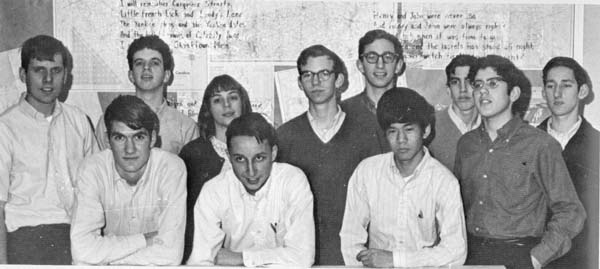
Walter Johnson High School "It's Academic" Team, 1968-69.
I went to North Bethesda Junior High and to Walter Johnson Senior High School. The High School was named after the famous baseball player. In high school I focused mainly on academics. My main extracurricular activities were the "It's Academic" TV quiz team (see below) and the Math Team, of which I was captain during my senior year.

Walter Johnson High School "It's Academic" Team, 1968-69.

Me at the "It's Academic" studio, 1969.
I was active in the Boy Scouts, earning the Eagle rank and holding leadership positions up to Senior Patrol Leader and Junior Assistant Scoutmaster. One of my most memorable experiences was in the summer of 1966, when I went on a 10-day backpacking trip at Philmont Scout Ranch in New Mexico (below, left). My Troop was sponsored by the Unitarian-Universalist Church to which I belonged. When I attended the World Jamboree in 1967 in Idaho, I displayed the Unitarian-Universalist emblem on my tent (below, right).
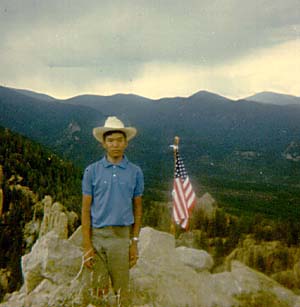
On top of the "Tooth of Time", Philmont, 1966 |
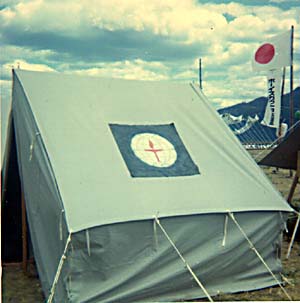
My tent, World Jamboree, 1967 |
Fishing was one of my favorite hobbies.
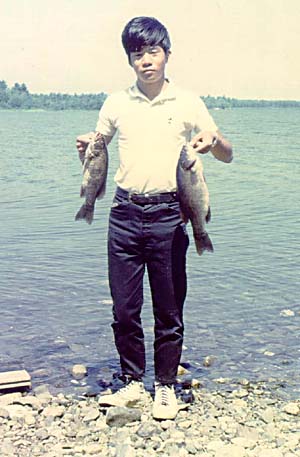
I experimented a lot on my own with high voltages, high temperatures, and nuclear radiation. Looking back on it, I'm lucky that I didn't get hurt. I made some modifications to Model T ignition coils to get higher voltages and bigger sparks out of them. I played around with carbon arcs which could melt copper pennies and iron nails. I collected alarm clock dials, which used real radium in those days, and other radioactive sources, like an orange Fiesta Ware bowl, which used uranium oxide in the glaze. Below is a strip of Kodak Tri-X film, which was placed in an opaque envelope and exposed to the Fiesta Ware bowl for a week, with some paper clips placed between the bowl and the film. Most of the film is darkened by absorption of nuclear radiation of some kind. The large white circle is due to the part of the bottom which is not glazed. The radiation was blocked by the paper clips, so they left shadows.

Film exposed to radiation from Fiesta Ware bowl, shadowed by paper clips.
Below is a schematic of a Geiger counter I made in eighth grade for a science fair project. Although it is not shown in the diagram, the person who helped me to get it to work gave me an isolation transformer, which may have saved me from electrocuting myself. After this, I made more advanced Geiger counters, including one with a divide-by-10 scaler, made with tubes, which triggered a thyratron, which then drove an electromechanical counter. Although transistors could have been used, the books that I had to refer to were old and included tube circuits.
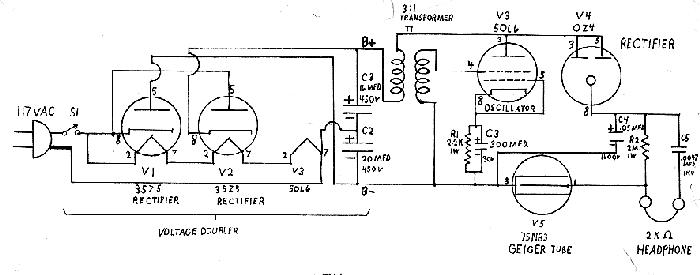
Geiger counter schematic, 1965.
In my last year of high school, I got interested in amateur radio, particularly in building my own equipment. This happened to coincide closely with a period of maximum solar activity, so I was often able to communicate over long distances, even to Europe and South America, with only a few tens of watts of output power and primitive antennas. Below, on the left, is my first transmitter, which was a one-tube crystal oscillator for the 40 meter (7 MHz) band. My first contact made with this transmitter was to WN9ZCR/4 in Ft. Gordon, Georgia on November 30, 1968 (from Maryland). Below, on the right, is my station at about the time I graduated from high school in 1969. I had a collection of homemade, kit-built, and modified military surplus equipment. The modern-looking green equipment is a Heathkit single-sideband transceiver. The black device to the right of it is a BC-348 World War II - vintage radio receiver. In the background is a Heathkit 2-meter AM transceiver and a rack of Command Set radio receivers. Eventually, I had some kind of equipment for every amateur band from 3.5 MHz to 220 MHz.
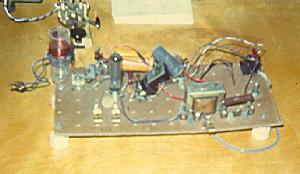
My first radio transmitter |
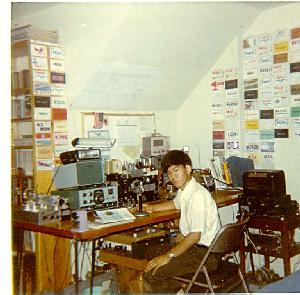
Ham radio station WA3LML, 1969 |
![]() Back to Itano family home page
Back to Itano family home page